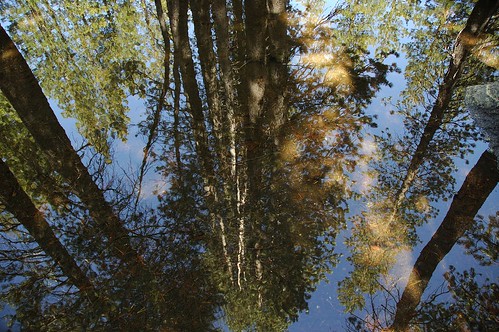Dream Reflections © Harold Davis
This photo is of reflections in this year’s high water at the western end of Lake Tenaya in Yosemite Park. One of the famous Ansel Adams images is a majestic black and white view of Lake Tenaya, the surrounding domes, and swirling clouds. Ansel’s image, of course, couldn’t be more different than this one of mine.
This brings up the habit of today’s photographers of following in Ansel’s “gold-plated” footsteps. Hordes of digital photographers wait for their own Ansel moments at famous spots in Yosemite Valley — Half Dome, El Capitan, Yosemite Falls, and the roadside pullout below Inspiration Point at the Wawona Tunnel. These gold-plated Ansel foot print spots extend well beyond Yosemite, including for example the view of Denali from Wonder Lake.
There’s nothing wrong with studying the work of a master, or even paying homage by imitation. But, of course, the danger is that today’s digital photographer’s end up with less than nothing — pale color renderings of monochromatic iconography that are very far from original and do not take advantage of digital’s power.
I’ve been thinking about a related issue: if Ansel Adams were here now, how would he feel about digital photography?
I was fortunate enough as a young photographer to meet Ansel on a number of occasions, including one particulalarly memorable long afternoon at his house by the Pacific Ocean in Carmel Highlands. Based on my impressions of the man, and from reading his books, I think he would have been deeply conflicted.
Ansel was no Luddite, and in fact a great innovator in the grand tradition of American tinkering. He was very proud of the stroboscopic light source that he had rigged for his enlarger to send enough light through his negatives to get the deep, dark tones for which his prints are justly famous. (He also enjoyed driving a current year Cadillac with the vanity plate Zone V back when the Cadillac brand still meant something.) Ansel would have appreciated the technology behind digital photography.
On the other hand, Ansel’s appreciation of photography was deeply intuitive and sensous. He was a man who narrowly missed a career as a concert pianist. As he said to me, it was a good thing, too considering how afflicted with arthritis his hands became. He reviewed my photographic prints by running those deformed but powerful arthritic hands across them, touching the surface of my photos to somehow “see” them better. The sensual Adams would have been deeply disturbed by the virtual nature of digital photography — the final expression of many digital photos is of course to appear online. He would have missed the disappearance of the craft of silver halide photographic printing.
Ansel was also deeply uneasy about color photography. Oh, of course he took some color photographs on commercial assignments (particularly for Polaroid Corporation), and said some nice things about color photos by masters such as Joel Meyerowitz. (He also said some nice things about my color prints!) But he was never comfortable with the ability of color film and color printing techniques to adequately reproduce the tonal range inherent in what our eyes can see. I think the combination of high-quality digital capture and digital darkroom software (meaning Photoshop) would have at least partially helped resolve this issue for him. (Processing a digital photo in Photoshop mimics the steps used to make a good conventional print: read more about this here.)
There’s no real way to know how Ansel Adams would have felt about digital photography, and I can only speculate. He was a pragmatist and a great experimenter, as well as one of the greatest photographers the world has known. It’s too bad he isn’t around so we can see what he would have done with digital.
By the way, here’s another (very un-Ansel) image I took recently of Lake Tenaya:
Rock and Reflections, Lake Tenaya © Harold Davis


Pingback: Photoblog 2.0: » Photoblog 2.0 Archive: » Mono Lake Is for the Birds and Brine Flies
Pingback: Photoblog 2.0: » Photoblog 2.0 Archive: » Digital versus Film and MacWrld Remindr
Pingback: Photoblog 2.0: » Photoblog 2.0 Archive: » Cyclamen
Pingback: Photoblog 2.0: » Photoblog 2.0 Archive: » Winter Afternoon in Yosemite
Pingback: Photoblog 2.0: » Photoblog 2.0 Archive: » Tulip
Pingback: Photoblog 2.0: » Photoblog 2.0 Archive: » Star Trails from Tunnel View